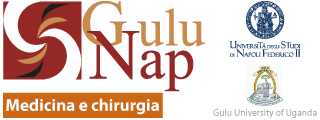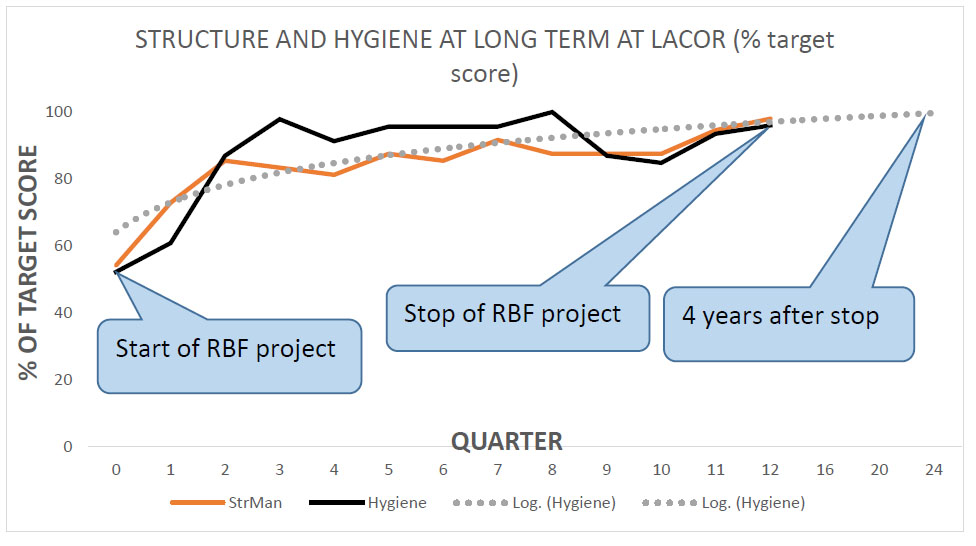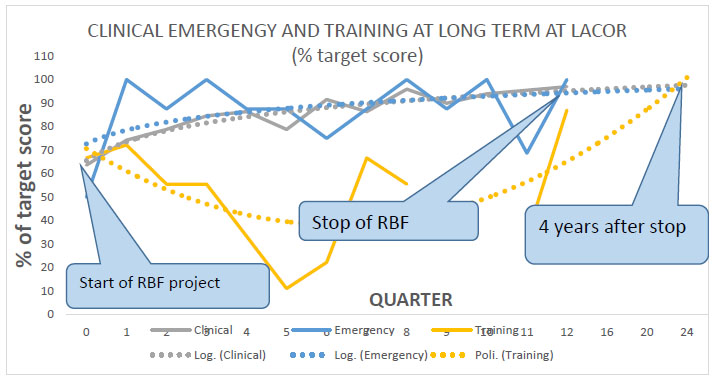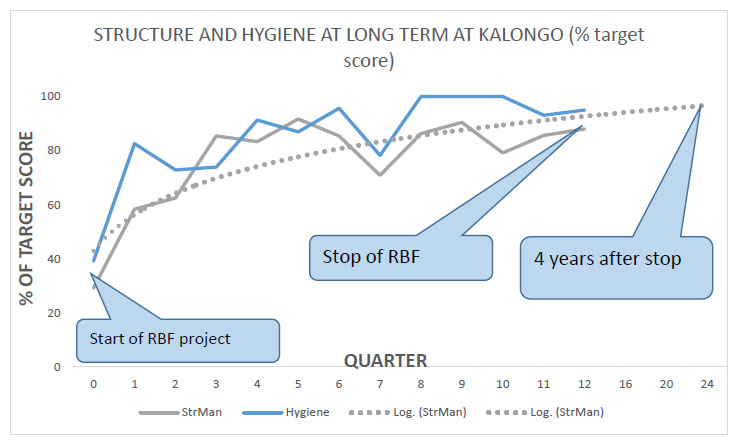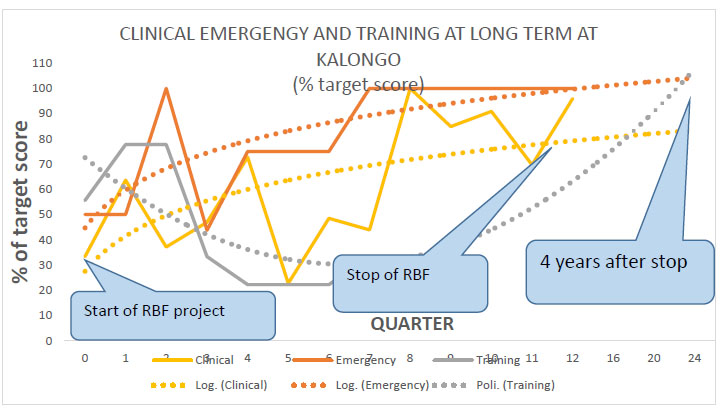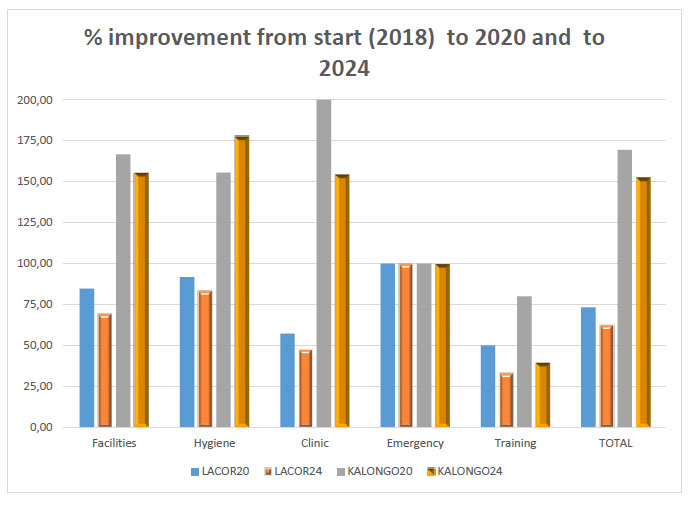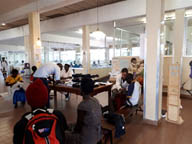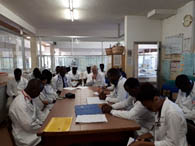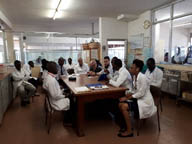I due ospedali del Nord Uganda (St. Mary’s Lacor ed Ambrosoli Kalongo) hanno partecipato per 3 anni ad un progetto, incoraggiato dalla Cooperazione Italiana, di Results Based Financing, mediante il quale il personale ospedaliero riceve ogni 3 mesi un bonus economico significativo in base ad i punteggi di qualità raggiunti ogni 3 mesi, valutati da una commissione esterna. Scarica il file Social Science and Medicine
Il Prof. Luigi Greco ha sviluppato gli obiettivi da raggiungere insieme al personale. Nel triennio 2018-2020 il livello di qualità dei servizi resi ai pazienti è aumentato dall’iniziale 40-50% del target all’ 87-92% del target in aree di struttura, gestione, capacità diagnostiche e terapeutiche. Dopo 4 anni dalla fine del progetto iniziale, abbiamo verificato, nel febbraio del 2024, che il livello di performance si è mantenuto elevato (88-95%) in tutte le aree valutate. Gli studenti ugandesi GULU-NAP e gli specializzandi italiani hanno avuto ed hanno ancora un ruolo importante nella promozione di obiettivi di qualità del servizio reso. Qualità di servizio che in un reparto dove muoiono 2-3 bambini al giorno, significa, non raramente, la differenza tra la vita e la morte.
“Result Based Financing, a change engine for paediatric services”
Reengineering pediatric services with Results-Based Financing (RBF) involves restructuring healthcare delivery systems to improve efficiency, quality, and patient outcomes, particularly in under-resourced areas like Northern Uganda. RBF programs typically provide financial incentives to healthcare providers based on the achievement of predefined results or outcomes, such as improved health metrics among the pediatric population.
This study considers a theoretical setting of healthcare RBF and then applies its main findings to two empirical cases, concerning S. Mary’s Lacor Hospital in Gulu and Dr. Ambrosoli’s Memorial Hospital in Kalongo before and after the Covid-19 pandemics (from 2018 to 2024).
The success of RBF programs depends on several factors, including the design of the incentive schemes, the context in which they are implemented, and the capacity of health facilities to respond to the incentives. Moreover, careful consideration must be given to ensure that RBF programs do not inadvertently create perverse incentives or widen health disparities.
Within this framework, the paper’s research question is to examine the Long-Term Effects of RBF Intervention in Children’s Wards in two main Northern Uganda hospitals (Lacor and Kalongo) in a pre- and post- Covid timeframe, from 2018 to 2024.
The study follows an IMRAD pattern and is structured as follows: after a short literature analysis, we present a model backed by empirical findings that precede a discussion and conclusion.
4.1.1. Lacor Hospital
Fig. 1 shows the percentage of the target score for the domain of Structure of the ward and Management of the Ward plus the action to preserve Hygiene and prevent infections at Lacor.
At Lacor the first year of the project was dedicated to covering the gaps in the respective domains, reaching, at the end of the first year (quarter 4) scores quite close to the set target. After the stop of the project (2020) there was no decay of the performance: at the point assessment of 2024, four years after the stop, the scores were very close to the target (see Table 1).
Fig. 2 shows the performance (as % of target score) in the domain of Clinical Management of patients, Emergency readiness, and training of students (nurses, medical doctors, and post-graduates) at Lacor.
The pattern is like the one observed in Fig. 1: during the first year a significant performance improvement, which remained stable up to the end of the project (2020) and is still kept four years after the end. A special note should be dedicated to the domain of training: during the second and third years, the occasional absence of senior supervisors and the uncontrolled rotation of students (especially medical) made this activity unstable. By 2024 also training appeared to be stabilized at a high level of performance.
4.1.2. Kalongo Hospital
Fig. 3 shows the percentage of the target score for the domain of Structure of the ward and Management of the Ward plus the action to preserve Hygiene and prevent infections at Kalongo.
At Kalongo the first year of the project was dedicated to covering the gaps in the respective domains, investing the resources gained by the RBF project, in the amendment and maintenance of the basic structure of the children’s ward. In the second year (quarters 5-8) the improvement toward the target became sensible, to reach in the third-year scores very close to the final objectives. After the stop of the project (2020) there was no decay of the performance: at the point assessment of 2024, four years after the stop, the scores were very close to the target (see Table 1).
Fig. 4 shows the performance (as % of target score) in the domain of Clinical Management of patients, Emergency readiness, and training of students (nurses, medical doctors, and post-graduates) at Kalongo.
The inconstant presence of the pediatrician affected considerably the stability of the performance of clinical management and the training of students. Especially in the second-year supervision and guidance appeared to be unstable, significantly affecting performance. By the third year, a significant improvement was observed, which was maintained as far as four years after the stop of the project.
Fig. 5 shows the improvement of quality scores as a percentage of the starting scores (at time 0 start of the project) either of the scores reached at the end of the project (2020) as well of the scores four years after the end of the project (2024) for Lacor and Kalongo Children’s Wards. (‘20’ = Scores 2020-scores of 2018)*100/Scores of 2018) , (‘24’ = Scores 2024-scores of 2018)*100/Scores of 2018).
The % improvement in performance in all domains was greater in Kalongo than in Lacor since the starting point of this hospital was significantly lower compared to Lacor. However, it is intriguing to observe the relative stability of the improvement after four years by the end of the project. For example, in Kalong there was a + 150% of the scores from the start of 2018 to the end (2020) for structure management and hygiene, but still a stable 150% improvement from 2018 to 2024 after the stop of the project. The domain of emergency was stabilized early and kept on a long time, while the area of training could improve less in Kalongo than at Lacor, due to the inconstant presence of supervision.
Napoli – 29 ottobre 2021
Aula Magna Storica – Università di Napoli Federico II
RESULT BASED FINANCING: A SUSTAINABLE APPROACH FOR INTERNATIONAL PARTNERSHIP
REPORT OF THE CHILDREN’S WARD
RBF PROJECT 2018-2020
March 27° 2021
Team of St.Mary’s Hospital Lacor
Team of Ambrosoli Hospital Kalongo
Data Analysis : L.Greco M.Arcidiaco
Napoli – 29 ottobre 2021
Aula Magna Storica – Università di Napoli Federico II
Scarica il programma dell’evento
RESULT BASED FINANCING: A SUSTAINABLE APPROACH FOR INTERNATIONAL PARTNERSHIP
Il finanziamento pubblico dei programmi sanitari è stato di recente caratterizzato da una crescente condizionalità nell’erogazione delle risorse. In questa tendenza tipicamente s’inscrivono i programmi di finanziamento basati sui risultati (Result Based Financing, RBF), che promettono premi, a individui o istituzioni, condizionandoli al raggiungimento degli obiettivi concordati.
Il St. Mary’s Hospital di Lacor (Gulu, Uganda) e la Fondazione Corti, dopo una prima esperienza con l’approccio RBF finanziata dal Governo inglese, hanno esteso l’adozione dei meccanismi premiali con il fine di migliorare la qualità delle cure erogate.
All’inizio previsti solo nel caso di attività ambulatoriali, grazie al contributo triennale dell’Agenzia Italiana per la Cooperazione allo Sviluppo (AICS), meccanismi di finanziamento basati sui risultati sono stati sperimentati anche nei reparti di pediatria del Lacor Hospital e del Dr Ambrosoli Memorial Hospital di Kalongo, mostrando un notevole potenziale sia nel migliorare la qualità dei servizi offerti, sia nel contribuire alla riduzione degli elevati tassi di mortalità infantile.
A partire da quest’esperienza, e dall’analisi delle evidenze accumulate negli ospedali di Lacor e di Kalongo, l’Università di Napoli Federico II, in collaborazione con la Fondazione Corti e la Fondazione Ambrosoli, promuove una giornata di riflessione sui sistemi di Result based financing e sulla loro efficacia nel favorire sostenibilità e qualità in ambito sanitario.
Results Based Financing al St. Mary’s Hospital di Lacor, Gulu, Nord Uganda.
Il Dr. Venice Omona, laureato tra i pionieri del progetto GULUNAP, specializzatosi in Pediatria, sta applicando con successo il sistema di Quality Assessment delle cure pediatriche offerte ai bambini del Nord Uganda, mediante il progetto RBF finanziato dalla Cooperazione Italiana e dalla Fondazione Piero e Lucille Corti di Milano, cui partecipa l’Ateneo Federico II.
La qualità delle cure di 100-150 bambini ricoverati ogni giorno, tra i quali 2-3 morti ogni giorno, ha avuto un sensibile miglioramento sollecitato dal progetto RBF. Il modello è stato assunto come esemplare per i progetti di sviluppo nel Nord Uganda.
RBF evaluation project
HAI Hospital Acquired Infection Project
ClinEvalua.xls
RBF 20 first 50 forms analysed
Nursing Form
Starting 2018
Result based financing
KALONGO HOSPITAL2018
THINGS TO DO
ACTIONS BEFORE RESULTS BASED FINANCING PROGRAM
Lacor 15 March 2018
Progress 2019
“Result Based Financing, un motore di cambiamento per i servizi pediatrici”
Intervento di rafforzamento delle qualità delle cure e dell’empowerment del personale sanitario
